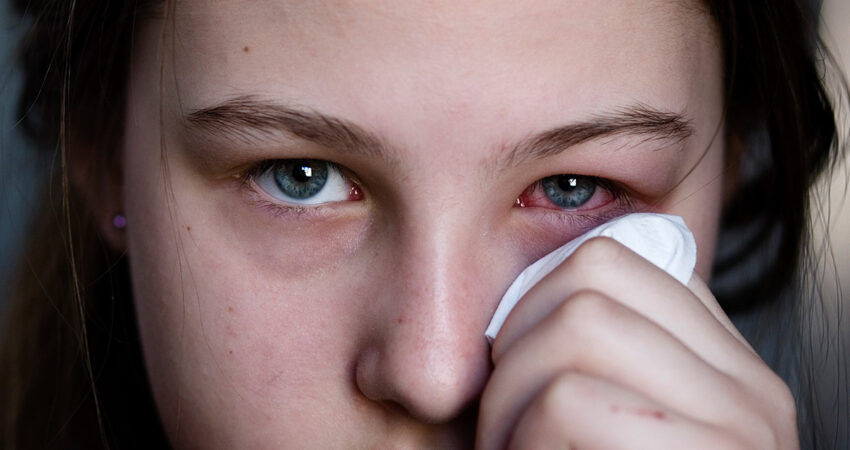If you have ever experienced the discomfort in your eye by going through the pain and annoyance. It can maybe due to the styes. Styes often resolve on their own but can also become dangerous sometimes which can be known through the symptoms it cause. One of the major complaints of people suffering from styes is headache. So the question is can a stye cause a headache? Let us explore it in detail!
What is a Stye and What Causes Them?
Stye’s medical name is hordeolum. It manifests as a small, red, and painful lump on your eyelid. It is typically caused by bacteria infecting the root of an eyelash or a tiny oil gland on the eyelid. As a result of this you experience inflammation. This leads to the formation of a painful pimple, often filled with pus.
There are two types of styes:
- Internal Styes.
- External styes.
- External Styes: They develop on the outer part of your eyelid.
- Internal Styes: It develops inside your eyelid. It is closer to your eyeball. It causes intense pain and discomfort as compared to external styes.
Symptoms of a Stye:
Now let me introduce you to the various symptoms of styes. It may help you to recognize them timely and take proper action:
- Red, Painful Bump: One of the starting signs of a stye is the presence of a red, and tender lump along the base of your eyelashes. You can even feel pain or discomfort. You feel it while touching it or blinking your eye.
- Eyelid Swelling: Styes often cause swelling of your affected eyelid. Your swelling may extend beyond the immediate area of the stye. It causes your entire eyelid to appear puffy or inflamed.
- Crust Formation: The stye may result in the formation of crust or discharge along the edge of your eyelid as it progresses. This discharge can vary in consistency, ranging from dry, flaky crusts to moist or pus-filled exudates among different individuals.
- Eye Irritation: You may experience sensations of itchiness, scratchiness, or a persistent feeling of having a foreign body trapped within your eye while suffering from stye. So, you will feel disturbed and uncomfortable.
- Sensitivity to Light: While having styes you may feel increased sensitivity to light. Your exposure to bright lights or sunlight can intensify your discomfort and irritation.
- Watery Eyes: Due to stye, your affected eye may produce excess tears or become excessively watery. But don’t worry about it. This watery discharge serves as your eye’s natural mechanism to flush out irritants or infectious agents.
- Redness of the Eyes: Styes often cause redness or discoloration of your affected eye. The conjunctiva, the thin membrane covering the white part of your eye, may appear pink or inflamed. It is due to the underlying infection or inflammation. It will be fine as the stye will be cured.
It is important for you to understand these symptoms. See your doctor ASAP if you feel any of them.
Can a Stye Cause a Headache?
No, let’s discuss our main point can a stye cause a headache? So, the answer is yes it has been seen in the patients suffering from stye. While a stye primarily affects your eyelid and its surrounding area. It’s plausible for certain symptoms associated with a stye to contribute to headache-like discomfort in you.
Relationship Between Styes and Headaches:
Let us further explore the relationship between styes and headaches. It can indirectly lead to various reasons which are:
- There can be a direct pain transmission. While stye is particularly located near your upper or lower eyelid margin. It can cause localized pain or tenderness. This discomfort may radiate to your adjacent areas like forehead or temples. It can potentially trigger headache-like sensations in you.
- Styes usually result in eye irritation, scratchiness, or a feeling of having a foreign object in the eye. You may unconsciously strain your eyes or alter your blinking patterns in response to this discomfort. So, this can lead to tension headaches. It can even exacerbate your existing headaches.
- One common symptom associated with styes is Photophobia, or sensitivity to light. Exposing yourself to bright lights or sunlight can intensify your eye discomfort. This triggers your headaches, especially if you are prone to light-induced migraines or tension headaches before.
- In some cases, a stye is accompanied by secondary symptoms such as fever, fatigue, or malaise. These systemic symptoms are although not directly related to the stye itself. They can contribute to a general feeling of unwellness or headache to you.
- The major underlying causes of styes are typically bacterial infections or blockages of oil glands. So, certain predisposing factors or underlying conditions may increase the likelihood of developing both styes and headaches in you. For instance, allergies, hormonal changes, stress, or underlying medical conditions can contribute to the development of both eye-related symptoms and headaches in your body.
So, if a headache occurs with a stye. There is the possibility of any of the above reasons behind your stye.
Who is at Risk of Styes?
There are certain factors that can contribute to causing styes in you.
- If you rub your eyes frequently.
- Don’t remove your eye makeup before going to bed.
- Don’t follow the proper hygiene while using contact lenses.
- There are some medical conditions that also contribute to the styes formation which are blepharitis, dandruff, rosacea, or diabetes.
These are all the factors or reasons that can develop a stye in your eye.
Treatment and Prevention:
In most cases, the styes can be managed effectively at home by applying a warm compress to the affected eye several times a day. This can be helpful to you in promoting drainage of the stye. it can also alleviate discomfort. However, if you are suffering from severe infection or persistent symptoms, medical intervention is necessary for you. It includes the prescribed antibiotics or minor surgical procedures to drain your stye.
If you want to prevent yourself from styes:
- Practice good hygiene.
- Avoid rubbing your eyes.
- Discard old eye makeup.
By following these steps you can save yourself from the styes.
FAQs:
Q1. Can a stye in your eye make you sick?
Yes, a stye can make you sick. It can lead to symptoms such as fever and malaise.
Q2. What symptoms does a stye cause?
Some common symptoms of a stye include:
eyelid swelling,
pain, redness, and
sometimes a discharge of pus.
Q3. Can a stye cause other problems?
Commonly a stye typically resolves on its own, but there are several complications such as spreading infection or a chalazion (blocked oil gland) may occur in some cases.
Q4. Can styes make you feel tired?
Yes, an indirect symptom of a stye is fatigue which may lead to the discomfort and pain.
Q5. Does a stye mean you are run down?
Yes, sort of because your stress and fatigue can contribute to the development of styes regardless of your overall health status.
Q6. What are the stages of a stye?
The stages of a stye are:
initial redness and swelling,
to the formation of a painful bump,
which is further followed by drainage of pus and eventual resolution.
Conclusion:
A stye typically presents in your eyes with symptoms in the eye area, such as redness, pain, and swelling. It can also lead to some secondary symptoms in you such as headaches, especially if complications arise. It is important for all of us to understand the causes, symptoms, treatment, and prevention strategies for styes so that we can manage this common eye condition effectively and minimize our discomfort incase suffering from it. So be careful and maintain proper hygiene!
Medical Disclaimer: We only provide information for educational purposes. Do not consider it a medical advice for you. In case of need, consult the healthcare professional for proper diagnosis and treatment.



